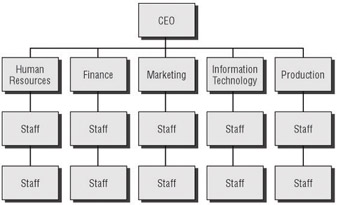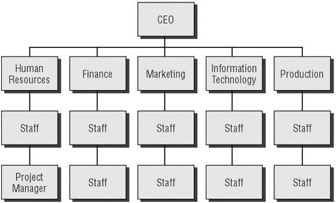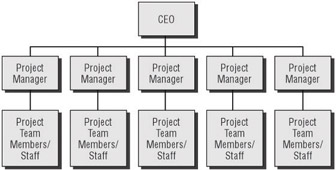Organizational Structure Impacts
The structure of your organization has a great impact on many aspects of project management, including the authority of the project manager and the process to assign resources.
Project managers can often become frustrated by what appear to be roadblocks in moving the project forward. It many cases the root issue is the organizational structure and how it operates. You must understand how your project fits within the organization in order to know the correct approach to resolving issues.
Functional Organization
The classic organization structure is the functional organization , as shown in Figure 1.2. In this structure, the staff is organized along departmental lines, such as IT, marketing, sales, network, public relations, customer support, and legal. Each person within a department has a clearly identified superior .

FIGURE 1.2 The Functional Organization
A project that is approved within a functional organization often has silos of work that are completed independently within each department. These silos may even be managed as separate projects.
The typical characteristics of a functional organization are limited authority for the project manager, part-time rather than full-time project resources, and an issue resolution process that must go up the departmental chain of command and laterally to other departments.
Project managers in functional organizations are often frustrated, because they are held accountable for the results of the project, but they have no means of holding team members accountable for project deliverables. The functional manager controls a team member's salary, bonus, and job rating. You may see some functional organizations that allow project managers input into team member compensation and rating, but the amount of weight it carries may not always be in proportion to the time spent on the project.
A project manager in a functional organization will benefit greatly from developing a good relationship with the functional managers. These managers can greatly influence the success of the project. Often they are asked to provide more resources to projects than they have available or qualified people. Working with the functional manager to resolve these issues is critical.
Matrix Organization
Another common organizational structure is the matrix organization , which is depicted in Figure 1.3. Matrix organizations typically are organized along departmental lines, like a functional organization, but resources assigned to a project are accountable to the project manager for all work associated with the project.. The project manager is often a peer of the functional staff managers. The project team members have two or more bosses; their functional manager and the project manager(s) they are reporting to.

FIGURE 1.3 The Matrix Organization
The typical characteristics of a matrix organization are low to moderate authority for the project manager, a mix of full-time and part-time project resources, and better interdepartmental communication. There are both weak and strong matrix organizations: the stronger the matrix, the more authority for the project manager.
Project managers in a matrix organization need to be very clear with both the project team members and their respective functional managers which results the team member is accountable for to the project manager and which are accountable to the functional manager. The team member should only be accountable to one person for a given result to avoid conflicting direction. Another trouble area in a matrix organization is how thin resources may be spread. If you have a resource assigned 50 percent to your project, it should be reflected in the work assigned by the functional manager or other projects to which the team member has been assigned. Addressing resource issues up front will prevent problems down the road.
Projectized Organization
The last type of organization structure we are going to discuss is the projectized organization , which is depicted in Figure 1.4. This organization is far less common in our experience than the other two. In this type of an organization, most of the work is project work, and the company is organized by projects.

FIGURE 1.4 The Projectized Organization
The typical characteristics of a projectized organization are a high level of authority for the project manager, full-time project resources, and a dedicated project support staff.
Project managers in a projectized organization are responsible for all decisions regarding the project. Team members are usually colocated , which enhances communication and efficiency.
The big drawback of a projectized organization is the how to handle staffing as one project ends. There may not always be a new project waiting for resources. The timing of increasing or decreasing resources can become very complex.
EAN: 2147483647
Pages: 156